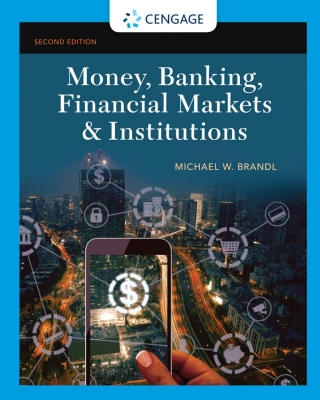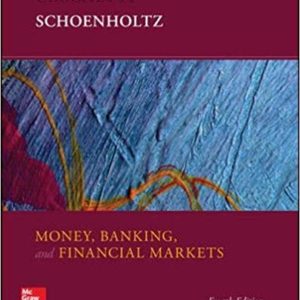Buy Money, Banking, Financial Markets & Institutions, 2nd Edition PDF ebook by author Michael Brandl – published by Cengage Learning in 2021 and save up to 80% compared to the print version of this textbook. With PDF version of this textbook, not only save you money, you can also highlight, add text, underline add post-it notes, bookmarks to pages, instantly search for the major terms or chapter titles, etc.
You can search our site for other versions of the Money, Banking, Financial Markets & Institutions, 2nd Edition PDF ebook. You can also search for others PDF ebooks from publisher Cengage Learning, as well as from your favorite authors. We have thousands of online textbooks and course materials (mostly in PDF) that you can download immediately after purchase.
Note: e-textBooks do not come with access codes, CDs/DVDs, workbooks, and other supplemental items.
eBook Details:
Full title: Money, Banking, Financial Markets & Institutions, 2nd Edition
Edition: 2nd
Copyright year: 2021
Publisher: Cengage Learning
Author: Michael Brandl
ISBN: 9781337904827, 9781337904827
Format: PDF
Description of Money, Banking, Financial Markets & Institutions, 2nd Edition:
Examine the globalization of today’s financial markets and explore how central banks have changed monetary policy because of the Great Recession. Study how technology is disrupting financial markets and join the debate over who protects consumers in financial markets. Rather than focusing on memorizing equations; moving lines on graphs; or reading long, dry chapters, Brandl’s MONEY, BANKING, FINANCIAL MARKETS AND INSTITUTIONS, 2E brings important financial concepts to life in a concise, reader-oriented approach. You clearly see the connections between the concepts you are learning and the macroeconomics you’ve already mastered as you examine today’s financial entities in detail, using the recent economic crisis as a backdrop. This inviting book reads almost as a conversation that encourages you to discuss and debate these important concepts with friends, colleagues, and even future or current employers. Learn the concepts behind money, banking, and financial markets – and more importantly, learn to connect those concepts to happenings in the world today.Important Notice: Media content referenced within the product description or the product text may not be available in the ebook version.
Table of Contents of Money, Banking, Financial Markets & Institutions, 2nd Edition PDF ebook:
Brief ContentsContentsPrefaceAcknowledgments for the Second EditionAcknowledgments for the First EditionAbout the AuthorChapter 1: Introduction1-1 Why Study This Stuff?1-2 The Key ComponentsChapter 2: Money, Money Supply, and Interest2-1 The Concept of Money2-2 Amount of Money and Money through Time2-3 Money Supplies2-4 The Price of Money: Interest Rates2-5 ConclusionChapter 3: Bonds and Loanable Funds3-1 Bonds Defined and Explained3-2 Bond Prices and Yields3-3 Supply and Demand for Bonds3-4 Supply and Demand for Loanable Funds3-5 The Bond Market and Loanable Funds Market Compared3-6 ConclusionChapter 4: Interest Rates in More Detail4-1 Interest Rates in More Detail and Default Risk4-2 Real versus Nominal: The Role of Inflation4-3 Taxes4-4 Yield Curves4-5 Yield Curve Applications4-6 ConclusionChapter 5: Financial Markets through Time5-1 US Financial Markets in the Early Twentieth Century5-2 Federal Reserve in the Early Days5-3 Financial Markets during World War II5-4 Postwar Boom: Home Mortgages, Consumerism, and European Unification5-5 Effects of Stagflation and the Reagan/Thatcher Revolution on Financial Markets5-6 Savings & Loans and Junk Bonds5-7 The Tech Bubble and Crash and Subprime Crisis5-8 ConclusionChapter 6: Aggregate Supply and Aggregate Demand6-1 Introduction and Keynes’s Aggregate Demand6-2 Shifts in Aggregate Demand6-3 Aggregate Supply6-4 The Rational Expectations Approach to AS/AD6-5 Business Cycles6-6 Modern Business Cycle Models6-7 ConclusionChapter 7: Banks and Money7-1 Why Banks Exist: Asymmetric Information7-2 Adverse Selection in Financial Markets7-3 Moral Hazard7-4 What Banks Do7-5 Simple Deposit Multiplier7-6 What the Simple Deposit Multiplier Tells Us and Its Problems7-7 ConclusionChapter 8: Central Banks8-1 Evolution of the Fed8-2 Current Structure of the Fed8-3 Responsibilities, Functions, and Balance Sheet of the Fed8-4 Other Central Banks: Bank of Japan and Bank of England8-5 Other Central Banks: European Central Bank and Bank of Canada8-6 ConclusionChapter 9: Monetary Policy Tools9-1 Overview9-2 Monetary Policy Tools: Discount Window and Term Auction Facility9-3 Monetary Policy Tools: Emergency Lending, Quantitative Easing, and the Required Reserve Ratio9-4 Problem with Tools: Money Demand9-5 Problems with Tools: Liquidity Traps, Budget Deficits, and The Zero Lower Bound9-6 Tools of the European Central Bank9-7 ConclusionChapter 10: The Money Supply Process10-1 The Money Supply Process10-2 More Changes in the Monetary Base and the Money Supply Multiplier10-3 Changes in Variables of the Money Supply Multiplier and the Great Recession10-4 ConclusionChapter 11: Monetary Policy Debates11-1 Monetary Policy and the Debate over Goals11-2 More Debates over the Goals of Monetary Policy11-3 Even More Debates over Monetary Policy11-4 Taylor Rule11-5 Monetary Policy and the Crisis11-6 Monetary Policy and Climate Change11-7 ConclusionChapter 12: Bank Management12-1 Bank Management: Balance Sheets12-2 Bank Deposits and Other Liabilities12-3 Bank Loans and Other Assets12-4 Off Balance Sheet Activities12-5 ConclusionChapter 13: Bank Risk Management and Performance13-1 Credit Risk13-2 Interest Rate Risk13-3 Liquidity Risk13-4 Other Risks13-5 Bank Performance13-6 ConclusionChapter 14: Banking Regulation14-1 Bank Regulation in the United States14-2 Bank Balance Sheet and Bank Capital: American Style14-3 Bank Regulation in the United States: Details on How It’s Done14-4 Consumer Protection and Failures14-5 Banking Regulation outside of the United States14-6 ConclusionChapter 15: Money Markets15-1 Money Market Characteristics and Purpose15-2 Money Market Instruments: Treasury Bills15-3 Money Market Instruments Other Than Treasury Bills15-4 ConclusionChapter 16: Bond Markets16-1 The Bond Market16-2 Corporate Bond Market16-3 Bond Rating Debate16-4 Debt Market during the Crisis16-5 ConclusionChapter 17: The Stock Market17-1 The Stock Market: Buying and Selling17-2 Pricing Common Stock17-3 Stock Market Overall: Performance, Indexes, and Regulation17-4 The Stock Market: Efficient or Not?17-5 ConclusionChapter 18: The Mortgage Market18-1 Mortgages and the Bigger Picture18-2 Basic Mortgage Concepts18-3 Nontraditional Mortgages in the Buildup to the Crisis18-4 The Secondary Mortgage Market and MBAs18-5 The Mortgage Market, Government Policies, and the Global Financial Crisis18-6 ConclusionChapter 19: Foreign Exchange Markets19-1 Foreign Exchange Market Basics19-2 Foreign Exchange Supply and Demand19-3 Foreign Exchange Equilibrium19-4 Foreign Exchange Regimes19-5 ConclusionChapter 20: Global Financial Architecture20-1 Modern Exchange Rate Regimes20-2 More Modern Exchange Rate Regimes20-3 The Fixed Exchange Rate Dance20-4 Creation of the Sister Institutions20-5 Sister Institutions: The IMF20-6 Controversies over the Sisters20-7 ConclusionChapter 21: Thrifts and Finance Companies21-1 Thrifts21-2 Savings & Loan Crisis and Today21-3 Credit Unions21-4 Finance Companies21-5 ConclusionChapter 22: Insurance and Pensions22-1 Insurance and Pensions22-2 Life Insurance22-3 Other Insurance22-4 Pensions22-5 ConclusionChapter 23: Mutual Funds23-1 Mutual Funds Overview23-2 Types of Mutual Funds23-3 Mutual Fund Fees23-4 Other Types of Funds23-5 ConclusionChapter 24: Investment Banks and Private Equity24-1 Investment Banks and Private Equity Overview24-2 Investment Bank Controversies24-3 Private Equity24-4 Private Equity Controversies24-5 ConclusionGlossaryIndex





